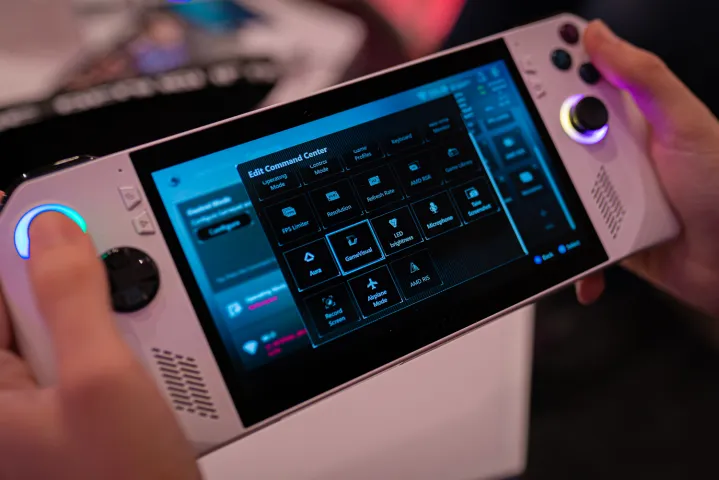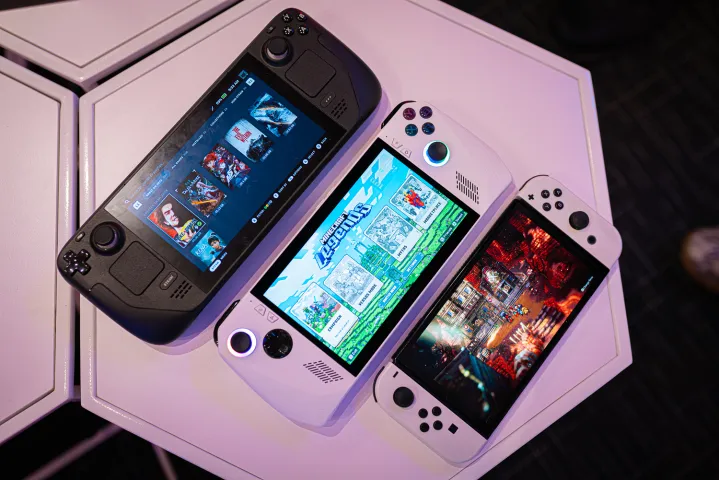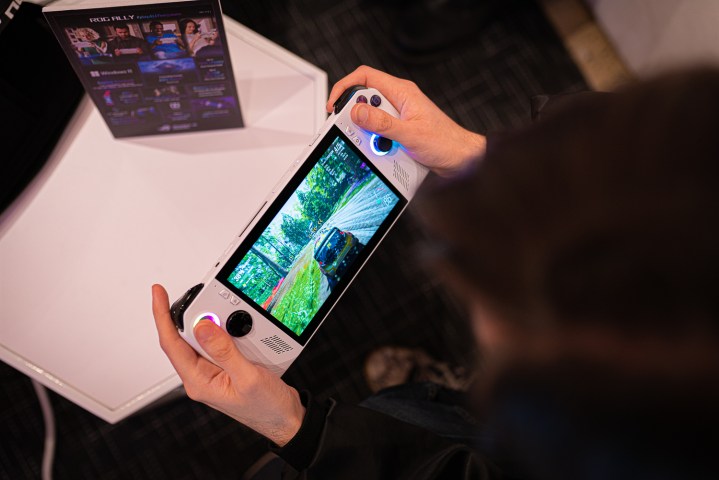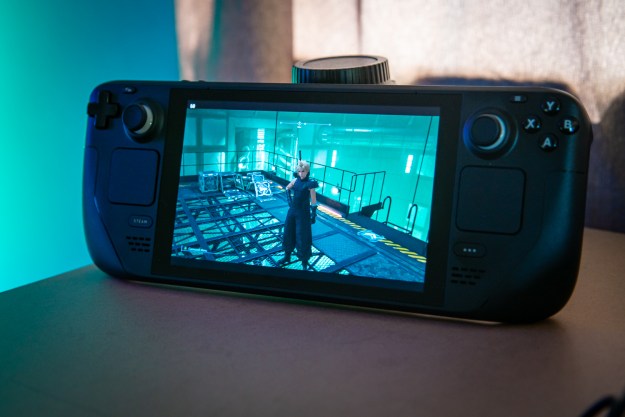While I’m a proud Steam Deck owner, it’s a system that I still have a hard time fully recommending to friends. Its bulky size, poor battery life, and scattershot game compatibility can make it a frustrating handheld from a casual perspective — especially if you’re looking for something that works as consistently as a Nintendo Switch every time it’s booted up. Usually, my recommendation ends up being to wait a few years for when Valve inevitably releases an improved version of the Steam Deck that irons out its flaws.
That advice might be about to change with the arrival of Asus ROG Ally. The new device is the first true competitor to Steam’s game-changing system. The Ally stuffs the guts of a powerful gaming laptop into a handheld form factor. It already impressed me on paper thanks to its strong specs, but actually using one in person fully sold me on it. After a good hour of tinkering with it, I’m already ready to toss my Steam Deck to the side forever and never look back.
At first pass, the Asus ROG Ally fixes almost every single problem I have with the Steam Deck. From a more comfortable design to a vastly improved screen, it’s the first device of its kind that doesn’t feel like a first-pass experiment. This could be the true start of the handheld PC era so long as the price is right.
A more portable portable
When I first picked up the Asus ROG Ally, I breathed an immediate sigh of relief. That’s because it feels significantly better than the Steam Deck in my hands. The system is both thinner and lighter than Valve’s offering, putting it in a happy middle ground between a Steam Deck and a Nintendo Switch. It’s more comfortable than either as well, with a much more traditional button layout that feels more naturally in-line with a modern Xbox controller. I have a few nitpicks about back button and D-pad placement, but it’s a notable improvement otherwise.
The only area where Steam Deck has an advantage is in button quality. The ROG Ally feels a bit like a third-party controller in spots rather than something premium. I wasn’t too impressed by its flat face buttons and find its perfectly level triggers and bumpers a little awkward. I’m mostly just left with a few questions about part durability and whether or not they’ll be easy to replace (and how much that would cost in the long term).

That’s one of the only battles where the ROG Ally doesn’t immediately come out on top, but it seems to be winning the war on every other front. That’s because it feels like Asus has put a lot of work into making sure it still feels like a portable device. The reduced size helps that, but other factors play a part too. While it was hard to fully hear the difference in a bustling showroom, the Ally seems to be a quieter system overall. Even better is that I was able to quickly toggle on a silent setting with a quick menu tap, cutting virtually any excess noise (though it caused Forza Horizon 4’s frame rate to plummet from 60 to 30 instantly, as you might expect).
Despite a flashier white design, I feel like I’d be far less self-conscious about breaking out a ROG Ally on an airplane or subway train. It’s a little more discreet overall, and it does that without sacrificing any power.
Customization potential
The level of customization here is another area that has me high on the system at first glance. The Ally uses a custom version of the Armoury Crate tool found in Asus’ laptops. Pressing a dedicated button on the device brings up a fast pop-out menu that lets users manage their performance settings and more with some quick taps. Midgame, I could easily pop it open and adjust my frame rate cap, resolution, refresh rate, and other settings with some fast taps. That menu can be entirely customized too, letting me add more boxes to enable video recording, airplane mode, performance overlay, etc. As someone who doesn’t love drilling into nitty-gritty sliders, it feels like a faster and more intuitive way to tweak settings on the fly.
Of course, I could go into more detail within the Armoury Crate app proper. From there, I can tweak anything from the directional pattern of the microphone to the exact color of the RGB lights under its joysticks (fortunately, those loud lights can be turned off entirely by setting the brightness to 0). At first glance, it doesn’t seem like you can get quite as granular with settings as you can on Steam Deck — there’s no slider for frame rate limit, locking you to common intervals like 30, 60, and 120 — but there’s still a fair amount of control here.

What catches my eye the most is its control customization potential. Every button on the Ally can be remapped to controller, mouse, keyboard, and numpad functions — and those can be mixed and matched together. Each button can be mapped with a secondary command too, allowing me to turn my right trigger into a shift key if I press it while holding down a back button. Better yet, buttons can be mapped with more complex keyboard commands. If I want, I can make it so that pressing a back button brings up the system’s task manager, minimizes a window, or calls up an on-screen keyboard. That makes browser navigation feel like a much less daunting prospect than it currently does on Steam Deck.
It also helps that the ROG Ally runs a familiar version of Windows 11 that’s easy to use with the system’s touchscreen. As someone who struggles with Linux, that’s another win in Asus’ corner, though your own preferences may vary. While I’m a fan of Valve’s clean SteamOS, it’s not much of a loss on the ROG Ally considering that Steam launches in big picture mode on the Ally and functions about the same. The only downside is a less organized software screen that doesn’t seem like it can be customized too much, though I appreciate that it can be sorted by which app the game is launching from (Xbox, Origin, Steam, etc).
Unquestionable specs
All of those perks are nice, but I imagine that the real selling point for most people comes down to performance and power. From that angle, the ROG Ally has a clear-cut advantage over the Steam Deck. The starkest difference is its 120Hz 1920 x 1080 display, which is a major improvement over Valve’s 60Hz 1200 x 800 screen. The difference was apparent before I even took out the Steam Deck to compare the two. The colors in games like Minecraft Legends and Moving Out looked clear and vibrant, avoiding the washed-out look I tend to get on the Steam Deck. Also nice is that Armoury Crate includes a suite of color temperature profiles that take advantage of the screen’s flexibility. It’s not quite up to par with the Nintendo Switch OLED, but it doesn’t feel like a compromise either.

I’d need to spend a little more time with the system to get a full sense of its performance advantage, but I’m already impressed. We already knew the Ally would be a step up considering it runs a Zen 4 processor while the Steam Deck has a Zen 2. The custom AMD chip seems more than capable of running current games like High on Life with relative stability. I’d really get to put it to the test with Forza Horizon 4 by flipping the system settings to Turbo. I was suddenly hitting the 120 frames-per-second (fps) mark and the Ally didn’t seem to break a sweat (perhaps thanks to its dual cooling fans). Granted, that’s last generation’s Forza game, but it’s still an impressive feat for a handheld as compact as this.
Will the extra power make it a longer-lasting system than the Steam Deck? Perhaps, but not by much. It feels one year ahead of it, which might not be enough incentive for those who already own the Steam Deck to change their loyalties. However, you can get a little more out of it depending on how prepared you are to buy into the Asus ecosystem. The Ally is compatible with the XG Mobile, ROG’s external GPU that contains an RTX 4090, letting players easily dock it to their PC and get a power boost. A demo station at the event I attended showed Dying Light 2: Stay Human running off the device and performing flawlessly on a PC.
What’s most important to me, though, is how it could resolve my current software headache. The Steam Deck’s most frustrating quirk is its unpredictable game compatibility. Due to Steam’s Proton layer, I’m not always sure a game I download will actually run on the system unless it’s explicitly verified. I’ve had multiple scenarios in the past year where I’d launch a game only to discover its cutscenes wouldn’t play or, worse, it couldn’t boot at all. With Ally running Windows 11, it already feels like a much less hacked-together device. Every game I booted on it worked with no fussing. I’ll need to see if that holds up with a wider selection of titles, but that alone could be enough to make me upgrade — especially with improved power adding extra reliability for modern games.

The only question mark I have is on battery life, though the Ally does seem on par with the Steam Deck there too. Asus estimates that the Ally’s battery supports up to eight hours of playtime, matching the Steam Deck’s top end. Naturally, that estimate will greatly vary based on how you dial up the specs. When maxing out Forza Horizon 4, it seemed like I was on track for the battery to run out within an hour. That’s nothing to sneeze at though, considering a lot of high-end games tap out around there on Steam Deck, but with much lower performance. The prognosis is good overall as long as you’re willing to turn some settings down when playing on the go.
Walking away from my hands-on session, I had to do some real soul searching. I’ve grown to love my Steam Deck over the past year, but I can’t imagine a scenario where I’d want to use it over the ROG Ally based on what I’ve seen so far. The Ally has a better screen, improved performance, a more portable design, deep customization options, and a less fussy Windows OS. Ultimately, my decision will come down to price, an important X factor that Asus is still keeping close to its chest. If it can keep that number reasonable, I’d be ready to pack my Steam Deck up and never look back.
Editors' Recommendations
- I’m secretly hoping that the leaked all-white Xbox Series X isn’t real
- I replaced my gaming laptop with a Legion Go, and I’m not going back
- I’m a lifelong Sonic fan. Here’s why I’m loving Sonic Dream Team
- I got Legion Glasses for gaming, but I’m actually using them for ASMR
- Despite its rocky start, I’m still optimistic about Overwatch 2’s future




